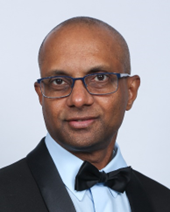Distinguished Lecturer (DL) talk in IEEE AP/MTT/ED Finland Chapter: Prof. Karu Esselle, AP-S DL
IEEE AP/MTT/ED Finland Chapter will host a talk of AP-S Distinguished Lecturer, Prof. Karu Esselle, University of Technology Sydney, Australia.
Date and Time
Location
Hosts
Registration
- Date: 26 Mar 2025
- Time: 01:00 PM to 02:00 PM
- All times are (UTC+02:00) Helsinki
-
 Add Event to Calendar
Add Event to Calendar
- Maarintie 8
- Espoo, Sodra Finlands Lan
- Finland 02150
- Building: Maarintie 8
- Room Number: AS3
- Click here for Map
Speakers
Prof. Karu Esselle of University of Technology Sydney, Australia
Near-Field Meta-Steering – A Low-Profile Method to Steer the Beam of Any Antenna
IEEE AP-Society Distinguished Lecture
Near-Field Meta-Steering – A Low-Profile Method to Steer the Beam of Any Antenna
In the history of Antenna Engineering, there has been only one universal method to steer the beam of any fixed-beam antenna. That’s physically tilting the antenna. This method has been implemented in many commercial antenna systems using motorised mechanical tilting and rotating systems. Now there is another way: Near-Field Meta-Steering, in which two flat phase-gradient metasurfaces (MS) are placed very close to the fixed-beam antenna, in its near field, and are rotated independently. This way, the beam of the antenna can be steered over a large range of zenith angles and complete azimuth range of 3600, without tilting or rotating the antenna. In fact, no part of the system is tilted.
A Meta-Steering antenna system is only slightly taller than the antenna itself. Lack of tilting means it is much shorter than conventional tilting antennas. In the future, one electronically reconfigurable near-field metasurface may provide 2D beam steering without any mechanical rotation.
Since this method was introduced in the seminal paper in 2017, together with the Near-Field Phase Transformation concept, it has been applied by many industry and academic researchers across the globe to develop novel antenna systems, and to steer the beam of all types of fixed-beam antennas, e.g. Fabry-Perot/resonant cavity antennas, reflector (dish) antennas, metasurface antennas, slot arrays, holographic antennas, and even some end-fire antennas, to name a few. several different types of metasurfaces have been developed, e.g. standard printed-circuit-board type, all dielectric, all metal, hybrid and 3D-printed, and some research outcomes have led to national prizes and awards. This distinguished lecture will review the research conducted by the speaker’s team as well as others in this modern and growing area.
Biography:

Karu is a Fellow of the Royal Society of New South Wales, IEEE and Engineers Australia. His large collection of recent awards include the most prestigious Space award in Australia – the “Winner of Winners” Excellence Award – as well as the Academic of Year Award at the 2022 Australian Space Awards, 2022 UTS Chancellor’s Medal, both the Excellence Award and the Academic of the Year Award at 2021 Australian Defence Industry Awards, and 2019 Motohisa Kanda Award for the most cited paper in IEEE Transactions on EMC in the past five years.
Karu has authored over 750 research publications and his papers have been cited over 16,000 times. His h-index is 63. Since 2002, his research income is over 33 million dollars. Karu has provided expert assistance to more than a dozen companies in USA, Europe and Australia. From 2018 to 2020, Karu chaired the Distinguished Lecturer Program Committee of the IEEE Antennas and Propagation (AP) Society, and has served in 8 global committees of this IEEE society. In addition, Karu has been a Senior Editor of IEEE Access and an Associate Editor of many international journals including IEEE Transactions on Antennas Propagation, IEEE Antennas and Propagation Magazine, IEEE Access and IET MAP. He was Director of WiMed Research Centre and Associate Dean – Higher Degree Research (HDR) at Macquarie University. He has also served as a member of the Dean’s Advisory Council and the Division Executive. Karu is a Director of Innovations for Humanity Pty Ltd. Karu’s research activities are posted in the web at https://www.uts.edu.au/staff/karu.esselle and https://en.wikipedia.org/wiki/Karu_Esselle .
Email:
Address:Sydney, Australia
